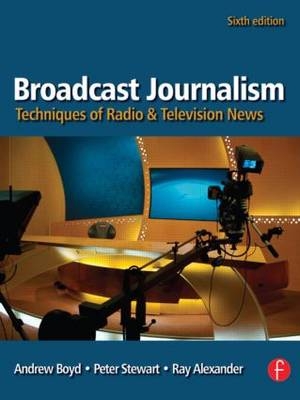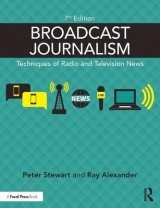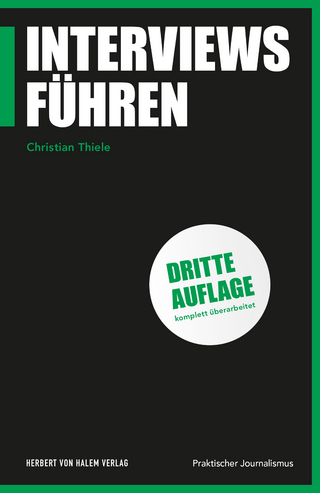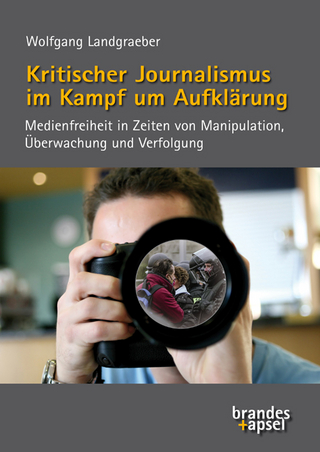
Broadcast Journalism
Focal Press (Verlag)
978-0-240-81024-9 (ISBN)
- Titel erscheint in neuer Auflage
- Artikel merken
This newest edition of Broadcast Journalism continues its long tradition of covering the basics of broadcasting from gathering news sources, interviewing, putting together a programme, news writing, reporting, editing, working in the studio, conducting live reports, and more. Two new authors have joined forces in this new edition to present behind the scenes perspectives on multimedia broadcast news, where it is heading, and how you get there.
Technology is meshing global and local news. Constant interactivity between on-the-scene reporting and nearly instantaneous broadcasting to the world has changed the very nature of how broadcast journalists must think, act, write and report on a 24/7 basis. This new edition takes up this digital workflow and convergence. Students of broadcast journalism and professors alike will find that the sixth edition of Broadcast Journalism is completely up-to-date.
Includes new photos, quotations, and coverage of convergent journalism, podcasting, multimedia journalism, citizen journalism, and more!
Peter Stewart is a highly experienced radio journalist and was Head of News at Essex Radio Group's nine stations for many years. More recently he was morning news editor at TalkSport and currently works in the BBC's newsroom for Radio Kent and South East Today. He's presented speech and music programmes on both commercial and BBC radio and has won a New York Radio award for news presentation. He trains radio news staff throughout the UK and abroad. Peter writes a weekly column in the trade publication The Radio Magazine. Manager & Lead Trainer for Television Journalism, BBC Training
Preface
SECTION ONE: THE PRINCIPLES OF BROADCAST JOURNALISM
A CAREER IN BROADCAST JOURNALISM
Why bother?
Writing Skills
Qualities in the broadcast journalist
Getting A Foot Into The Door
The interview
Multi-tasking
Surviving Editorial Meetings
Formal and practical training for broadcast journalism
WHAT MAKES NEWS?
Audience: What Matters To Me?
News You Can Use
Where did it happen?
Relevance
Immediacy
Interest
Drama and Impact
Entertainment and Celebs
New, true and interesting
Different Types of News
Emergencies
Crime
Government
Planning and developments
Conflict and controversy
Pressure and lobby groups
Industry and business
Health and Medicine
Human interest
Sport
Seasonal news
Special local interest
Weather
Traffic
Animals
The Final Checklist
SECTION TWO: NEWSGATHERING
ETHICS AND RESPONSIBILITY
Regulation
The Law
Being Web Wise
The Myth Of Objectivity
Children
Ethics In Citizen Journalism
Reporting civil disorder
Camera bias
Sensationalism
Privacy and voyeurism
NEWS SOURCES
Reporters
Stories from Consumers
Hoaxes
Contacts and Sources
Newsroom Diary
Files
Check Calls
Emergency Services Radio
Politicians
Pressure Groups
Staged Events
News Releases
Syndicated recordings Freelances
Wire Services and News Agencies
The Network
Other News Media Cross-Platform Material
GETTING THE STORY
Newsroom Conference
Copytasting
Balance of News
Visuals and Actuality
The Brief
The Angle
Chasing the Contact
Staged News Conferences
Beating the Clock
Work to Sequence
Don't Panic
SECTION THREE: WRITING FOR BROADCAST
CONVERSATIONAL WRITING
Telling the Story
Writing for a Mass Audience
No Second Chance
Confusing Clauses
Inverted Sentences
Plain English
Familiar Words
Easy Listening
Accurate English
Keep It Concrete
Make It Interesting
Contractions
NEWSWRITING
The News Angle
Multi-Angled Stories
Hard News Formula
The Intro
Placing Key Words
Features Openers
Developing the Story
The WHAT formula Signposting
Last Line
Last Words
Accuracy
BROADCAST STYLE BOOK
Cliches
Journalese
Hyperbole
Adjectives
Quotations
Attribution
Contentious Statements
Immediacy
Active
Positive
Redundancies
Repetition
Homonyms
Singular or Plural?
Pronouns
Punctuation
Spelling
Abbreviations
Figures
Proof Reading
Ambiguity
SECTION FOUR: INTERVIEWING
THE INTERVIEW
The Interviewer's Skill
Different Types of Interview?
A Disaster Story? Hard News
Informational
Investigative
Adversarial
Interpretative
Personal
Emotional
Entertainment
Actuality Only
The Disaster Story Continues
SETTING UP THE INTERVIEW
Background
A Plan of Campaign - The Questions
Get Your Facts Right
Fit the Brief
Check Arrangements
Approach
The Questions
Winding Up the Interview
Being Interviewed Yourself: The Q & A
FROM 2-MINUTE HEADLINES TO 24-HOUR NEWS
The Bulletin
News Programmes
Documentary
Verite
24-Hour News
Who Does What?
SECTION FIVE:THE NEWS PROGRAMME
ITEM SELECTION AND ORDER
'A Fair Picture . . .'
Second Thoughts
Item Order
Local Considerations
Foreign Coverage
Producing a Running Order
PUTTING THE SHOW TOGETHER
Winning an Audience - The Openers
Keeping and Audience - Headlines and Promotions
Actuality
Pictures
Graphics
Programme Balance - Being All Things to All People
And Now the Good News?
MAKING THE PROGRAMME FIT
Cutting
Filling
Backtiming
SECTION SIX:PRESENTING THE NEWS
NEWS ANCHORS AND PRESENTERS
The Talent
Qualities of a Newscaster
More Than Just a Newsreader . . .
Professionalism
Voice
'ON AIR!'
Performance
Prescence
Getting Through to the Audience - Rapport
Know Your Material
Ad-Libs
The Gate
Making a Swift Recovery
Corpsing
Relaxation
NEWSREADING MECHANICS
Speed
Breathing
Projection
Emphasis
Pitch
Microphone Technique
Using the Prompter
Noise, Noise, Noise
Bringing the Story to Life
SECTION SEVEN: RADIO NEWS COVERAGE
STORY TREATMENT
Breaking News (Bulletin US)
Headline
Copy Story
Voicer or Voice Report
Teaser or Taster
Voice Report from the Scene
Interview
Newsclip
Package
Mini-Wrap or Bulletin Wrap
SECTION EIGHTTHE EQUIPMENT
RECORDING
Principles of Recording
Using Portable Sound Recorders
Digital Recorders
Before the Interview
EDITING
'You Can't See the Join'
Unethical Editing
Basic Production
Multi-Tracking
Studio Mixing
Types of Fade
THE STUDIO
On-Air Studio
Talks Studio
The Contributions Studio
Remote Studios
Radio Car
Outside Broadcast Vehicle
Mobile Phones
Obscenity Button
SECTION NINE:TELEVISION
THE NEVER ENDING STORY - THE SHARING TELEVISION NEWSROOM
Television Newsrooms And The News Story
Advantages and Disadvantages
In and Out
A newsroom core server
Order from chaos - the journalist's most basic need-to-know
TV Script Types
Live Breaking News - 24/7 Newsroom
The role of UGC (User Generated Content) and the 24-hour newsroom
Types of citizen journalism
SCRIPTING TELEVISION JOURNALISM
The Intro (Cue or Link)
Complement The Pictures With The Narrative
Writing To Sound
Keep Detail To A Minimum
The Television News Package
Balancing Words With Pictures
Using Archive Pictures
The Bottom Line
GATHERING TELEVISION NEWS
Filming for TV Journalism
Cameraman/Camerawoman/Cameraperson!
Sound Recordist
Lighting technician
The Video Journalist checklist
The Journalist as advance guard - a Recce
CAMERA SHOTS
Hold the shots
Grab action shots first
Shoot for impact
Shoot in sequences
Context
Sound
Sound-bites and interviewee clips
Cutaways and bridge shots
Reverses
The Line
Continuity
Piece to Camera (PTC) also known as Stand Uppers
Special film equipment
EDITING THE SOUND AND PICTURES
Sequence of shots
Shot Length
Telescoping the action
Desktop Editing
The craft editor
The timer (time code)
The edit controller
Video mixing
Recording the commentary
Audio mixing
Editing shots for interviews
Using music
GOING LIVE - LIVE TV REPORTING IN VISION
What works well?
What works less well?
Top Tips
GRAPHICS AND DIGITAL DISPLAY VISUALS
Stills and frame grabs
Writing to still pictures and screen insets
Overlays and Chromakey (CSO)
Big Screen Video Wall
Acronyms in Visuals
PRESENTING TELEVISION NEWS
Qualities of the television news presenter
What To Wear
Men And Their Ties
Colours and fabrics
Autoscript T
"Fill For Ten Seconds!
Nerves
Make Up and Perception
"Coming up.
THE TELEVISION NEWS STUDIO
Standby for transmission
The Set
Lighting
Cameras
Sound
The floor manager
Control Room
The Director
Running order and the studio
GLOSSARY
| Erscheint lt. Verlag | 29.2.2008 |
|---|---|
| Verlagsort | Oxford |
| Sprache | englisch |
| Maße | 189 x 246 mm |
| Gewicht | 885 g |
| Themenwelt | Sozialwissenschaften ► Kommunikation / Medien ► Journalistik |
| ISBN-10 | 0-240-81024-4 / 0240810244 |
| ISBN-13 | 978-0-240-81024-9 / 9780240810249 |
| Zustand | Neuware |
| Informationen gemäß Produktsicherheitsverordnung (GPSR) | |
| Haben Sie eine Frage zum Produkt? |
aus dem Bereich



